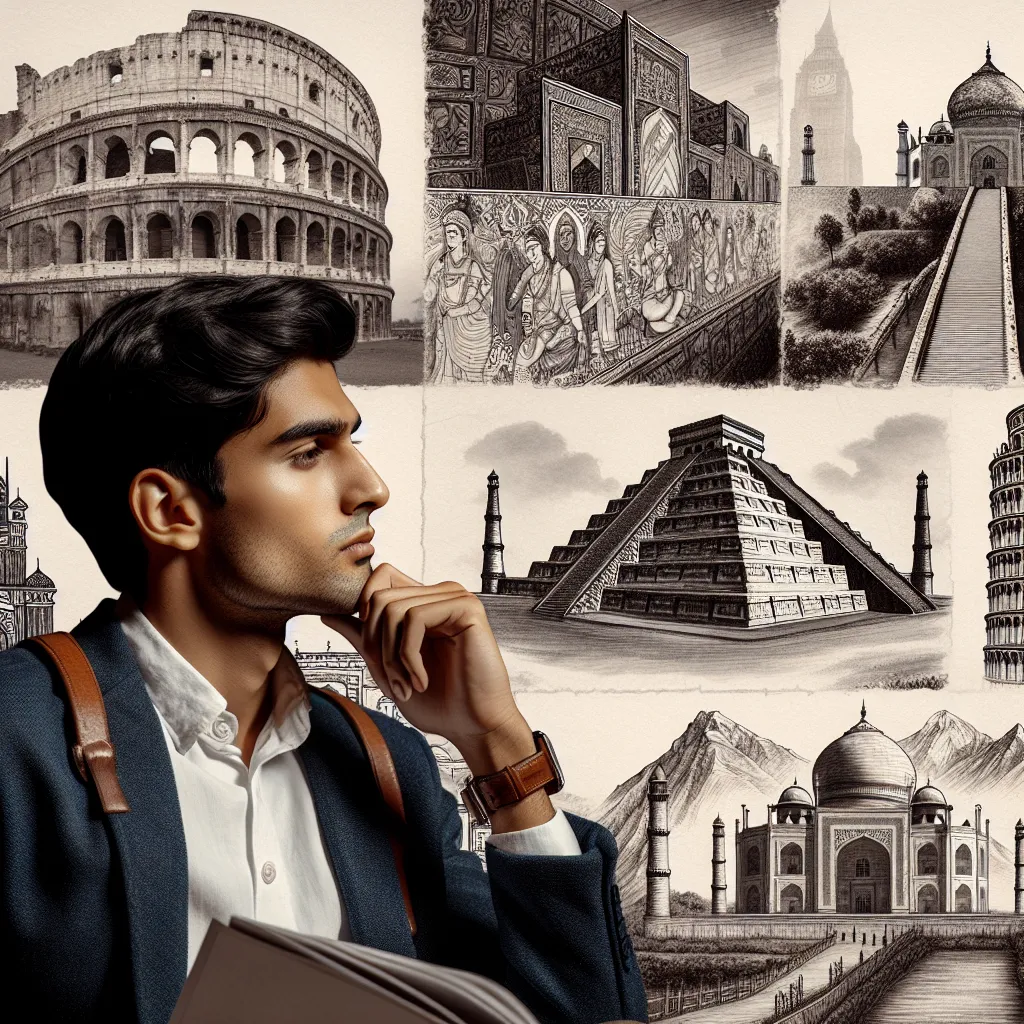As an IELTS examiner and experienced English teacher, I understand the challenges students face when tackling the speaking section of the IELTS exam. In this article, we’ll focus on how to effectively describe a historical building you’d like to learn more about, a topic that frequently appears in IELTS speaking tests. We’ll provide sample answers, useful vocabulary, and expert tips to help you achieve a high band score.
Nội dung bài viết
 Famous Historical Buildings
Famous Historical Buildings
Part 1: Introduction and Interview
In Part 1 of the IELTS Speaking test, you may encounter questions related to historical buildings. Here are some common questions and a sample answer:
Sample Question and Answer
Examiner: Do you have any interest in historical buildings?
Band 6-7 Answer:
Yes, I do have some interest in historical buildings. I find them fascinating because they tell us a lot about the past. I enjoy visiting old castles and churches when I travel to new places. It’s interesting to see how people lived and built things in the past.
Band 8-9 Answer:
Absolutely! I’m deeply fascinated by historical buildings. They serve as tangible links to our past, offering invaluable insights into the architectural styles, cultural values, and technological capabilities of previous generations. I’m particularly intrigued by how these structures have withstood the test of time, often surviving centuries of social and political upheavals. Whenever I travel, I make it a point to visit historical sites, as I believe they provide a unique window into the soul of a place and its people.
Part 2: Long Turn (Cue Card)
In this section, you’ll be given a cue card with a topic and some bullet points. You’ll have one minute to prepare, then you should speak for 1-2 minutes on the topic.
Sample Cue Card
Describe a historical building you would like to learn more about.
You should say:
- What the building is
- Where it is located
- What you know about its history
- Why you want to learn more about it
Sample Answers
Band 6-7 Answer:
The historical building I’d like to learn more about is the Colosseum in Rome, Italy. It’s a huge amphitheater in the city center. I know it was built a very long time ago, during the Roman Empire. It was used for gladiator fights and other public events.
I’ve seen pictures of the Colosseum, and it looks really impressive. It’s amazing that such a big structure could be built so long ago. I want to learn more about it because I’m curious about how it was constructed without modern technology. I also want to know more about the events that took place there and how it has survived for so many centuries.
Band 8-9 Answer:
The historical edifice I’m particularly keen to delve deeper into is the awe-inspiring Angkor Wat temple complex in Cambodia. This architectural marvel is nestled in the lush jungles of Siem Reap province, standing as a testament to the ingenuity and artistic prowess of the ancient Khmer civilization.
My current knowledge of Angkor Wat, while limited, has piqued my curiosity immensely. I’m aware that it was initially constructed in the 12th century as a Hindu temple dedicated to Vishnu, later transitioning into a Buddhist sanctuary. The sheer scale of the complex, with its intricate bas-reliefs and towering spires, speaks volumes about the advanced engineering and artistic skills of its creators.
What fascinates me most about Angkor Wat is its ability to seamlessly blend religious symbolism with astronomical precision. I’m eager to unravel the mysteries behind its perfect symmetry and the significance of its orientation to the solar calendar. Moreover, I’m intrigued by how this magnificent structure has endured centuries of neglect and natural weathering, yet still stands as a crowning jewel of Cambodian heritage.
My desire to learn more about Angkor Wat stems from its multifaceted significance – as an architectural wonder, a historical chronicle, and a spiritual beacon. Understanding the intricacies of its construction and the rich tapestry of stories etched into its walls would offer invaluable insights into the cultural, religious, and technological advancements of the Khmer Empire. Additionally, exploring how Angkor Wat has shaped Cambodia’s national identity and its role in modern times would provide a fascinating perspective on the enduring impact of historical monuments.
Follow-up Questions
Examiner: How do you think we can encourage young people to learn about historical buildings?
Band 6-7 Answer:
I think we can encourage young people to learn about historical buildings by making the experience more interactive and fun. We could use technology like virtual reality to show how these buildings looked in the past. Schools could organize field trips to historical sites, which would make learning more interesting than just reading about them in books.
Band 8-9 Answer:
Encouraging young people to engage with historical buildings requires a multifaceted approach that blends education with entertainment. One effective strategy would be to harness the power of technology by developing immersive, gamified experiences that allow youth to explore these structures virtually. Augmented reality apps, for instance, could overlay historical information and reconstructions onto real-world views of the buildings, bringing history to life in a way that resonates with the digital native generation.
Moreover, we should strive to contextualize these buildings within narratives that young people find relevant and compelling. This could involve highlighting the human stories associated with these structures – tales of innovation, struggle, and triumph that humanize history and make it more relatable. Educational programs could also draw parallels between historical architectural challenges and modern-day issues, demonstrating the enduring relevance of these ancient marvels.
Lastly, involving young people in conservation efforts can foster a sense of ownership and responsibility towards historical heritage. Hands-on workshops, citizen science projects, and youth-led guided tours could empower young individuals to become active stewards of these cultural treasures, ensuring their preservation for future generations.
Part 3: Two-way Discussion
In this section, the examiner will ask you more abstract questions related to the topic in Part 2.
Examiner: What role do historical buildings play in modern society?
Band 6-7 Answer:
Historical buildings play an important role in modern society. They help us remember our past and understand how people lived before. These buildings are often popular tourist attractions, which can be good for the local economy. They also make cities more interesting and beautiful. Sometimes, old buildings are used for new purposes, like turning old factories into museums or apartments.
Band 8-9 Answer:
Historical buildings serve a multifaceted role in contemporary society, acting as tangible bridges between our past and present. Primarily, they function as custodians of cultural memory, preserving the architectural and artistic achievements of our ancestors and providing invaluable insights into the social, economic, and technological contexts of their times.
These edifices also play a crucial role in shaping urban identity and contributing to the aesthetic fabric of our cities. They offer a welcome counterpoint to modern architecture, creating visually diverse and historically rich urban landscapes that enhance the quality of life for residents and visitors alike.
From an economic perspective, historical buildings are often catalysts for tourism and urban regeneration. Cities with well-preserved historical districts tend to attract more visitors, boosting local economies. Moreover, the adaptive reuse of historical structures for modern purposes – such as converting old warehouses into trendy lofts or repurposing industrial sites as cultural centers – exemplifies sustainable urban development and fosters a sense of continuity amidst rapid change.
Perhaps most importantly, historical buildings serve as powerful educational tools, offering tangible, immersive experiences that bring history to life in ways that textbooks cannot. They provide opportunities for intergenerational dialogue and help strengthen community bonds by fostering a shared sense of heritage and pride in local history.
In essence, historical buildings in modern society act as anchors of collective identity, drivers of economic development, and invaluable resources for education and cultural enrichment, underscoring the importance of their preservation and integration into contemporary urban planning.
Key Vocabulary and Phrases
To elevate your IELTS Speaking performance when discussing historical buildings, consider using these sophisticated terms and expressions:
-
Architectural marvel /ˌɑːrkɪˈtektʃərəl ˈmɑːrvəl/ (noun phrase): A building that is exceptionally impressive in design and construction.
Example: “The Taj Mahal is widely regarded as an architectural marvel of the Mughal era.” -
Cultural heritage /ˈkʌltʃərəl ˈherɪtɪdʒ/ (noun phrase): The legacy of physical artifacts and intangible attributes inherited from past generations.
Example: “Preserving historical buildings is crucial for maintaining our cultural heritage.” -
Restoration /ˌrestəˈreɪʃn/ (noun): The process of returning something to its original condition.
Example: “The restoration of the ancient temple took several years to complete.” -
Historically significant /hɪˈstɒrɪkli sɪɡˈnɪfɪkənt/ (adjective phrase): Having importance in history.
Example: “The Palace of Versailles is a historically significant site that attracts millions of visitors annually.” -
To stand the test of time (idiom): To remain useful, popular, or important for a long period.
Example: “The Pyramids of Giza have stood the test of time, surviving for over 4,500 years.”
Examiner’s Advice
To achieve a high band score in the IELTS Speaking test when discussing historical buildings:
-
Develop your vocabulary: Familiarize yourself with architectural terms and historical periods. This will allow you to speak more precisely about different aspects of historical buildings.
-
Practice describing buildings: Regularly practice describing buildings you see in your daily life or in pictures. Focus on aspects like architectural style, historical significance, and your personal impressions.
-
Stay informed: Read about famous historical buildings and current preservation efforts. This will help you provide more informed and thoughtful responses.
-
Use complex sentence structures: Incorporate a mix of simple and complex sentences in your responses. This demonstrates linguistic flexibility and can boost your grammar score.
-
Show personal interest: When possible, relate the topic to your personal experiences or interests. This can make your responses more engaging and natural.
Remember, the key to success in the IELTS Speaking test is not just about what you say, but how you say it. Aim for fluency, coherence, and natural expression, and you’ll be well on your way to achieving a high band score.
For more tips on improving your IELTS Speaking performance, check out our guide on how to describe a place you visited that left a lasting impression. This skill can be particularly useful when discussing historical buildings you’ve seen in person.


